“Hey, what do you think of this headline?”
I hear that question from fellow copywriters and marketers almost every day. And it’s enough to make me scream.
Why? Because, without context, “headline” could mean any of the following:
- Blog post title
- Email subject line
- Facebook ad headline
- Sales page headline
- Opt-in page headline
- Home page headline
- An SEO title
- The beginning of a social media post
- Text for a social media image
- An in-app chat message headline
- The list goes on…
See the problem? They’re all completely different things…yet we so often treat them exactly the same.
When you’re getting to write any of the above, it’s so easy to bust out your go-to collection of all-purpose headline templates and plug in whichever happens to feel best.
What’s harder is forcing yourself to stop and ask yourself, “Wait, WTF is this headline for, anyway?”
I don’t mean what medium is it for. I mean what, specifically, is its job?
That question, of course, was answered decades ago by legendary copywriter Joseph Sugarman, who proposed that copy should read like a slippery slide: the purpose of the first sentence (in many cases, the headline) should be to get you to read the second sentence.
But here’s the catch: the best way to fulfill that job varies greatly depending on the type of headline you’re writing.
The type of headline that will make you want to read the next part on a long-form sales page differs greatly from the type of headline that will be effective on a Facebook ad.
So, to clear up all this trouble, I’m going to show you the six types of headlines you should know how to write, while highlighting exactly what makes the process of writing each one different:
- Long-form sales page headlines
- Opt-in page headlines
- Facebook ad headlines
- Blog post headlines
- Home page headlines
- Subject lines
Without This Critical Ingredient, Headline Templates Will Only Get You So Far…
Headline templates/formulas are great. Every copywriter I know, including me, uses them often.
But what often goes unsaid is that it’s equally important to know when a particular template fits the format in which you’re creating the headline, and when it doesn’t.
This post will equip you with the thought process to tell the difference.
So let’s get started.
How to Write Long-Form Sales Page Headlines
Ah, the long-form sales page.
Everyone hates them, but all they do is convert. At least the good ones do, anyway.
And the good ones almost always start with one of two (sometimes both) things:
- Connecting with an emotional need
- Connecting with an intensely-desired result
Let’s look at a couple examples to show you what I’m talking about:
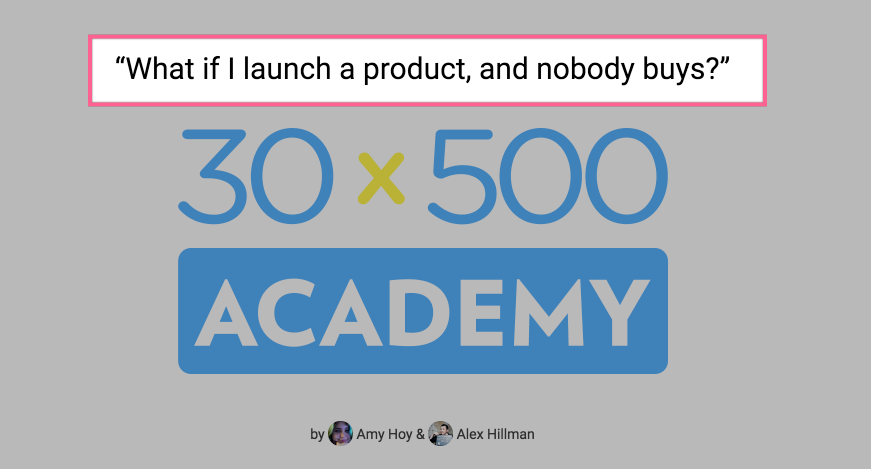
This is from the sales page for Amy Hoy and Alex Hillman’s 30×500 online course.
In case you were wondering, it’s 4,223 words long. And it’s a perfect example of great long-form copy.
But it all starts with that one quote I highlighted above, a headline that does one thing—connects with what Amy and Alex know is their ideal prospects deepest-seated fear: building something, putting themselves out there, and hearing nothing but crickets.
Failure, basically.
So why do emotional headlines work so well on long-form sales pages? Because if you drop a 4,223-word tome of a sales page in front of someone, they have to be driven to take the plunge down the page.
Of course, the real success of the page isn’t determined by whether people read it or not, but by if those people purchase.
Well guess what? Study after study has shown that emotion is a more powerful purchasing motivator than anything else.
Emotional headlines not only get visitors’ attention and motivate them to continue down the page, they can spark the connection the rest of your copy needs to drive home in order to close the sale.
But emotional appeals aren’t always appropriate, especially if you’re writing for B2B. That’s where results come in.
Check out this headline from the smart folks at ConversionXL:
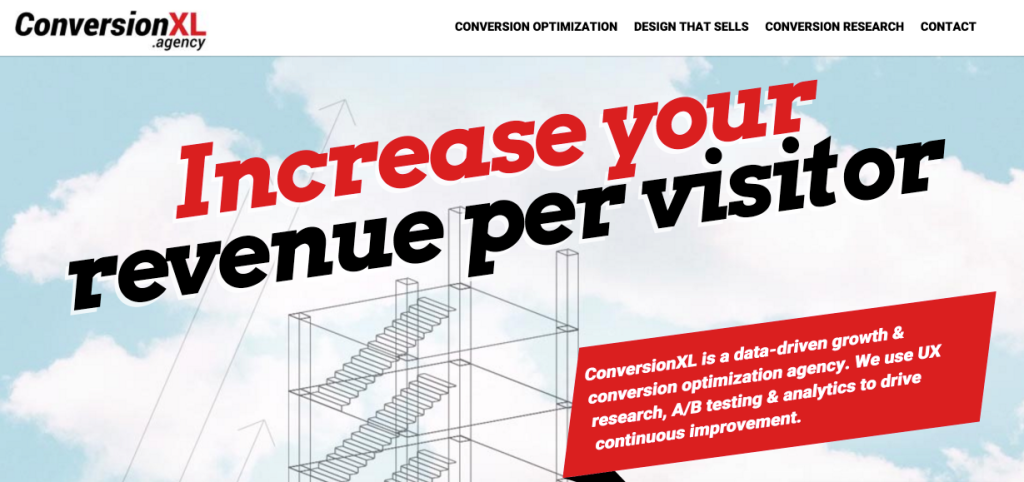
Peep Laja and his team built this long-form page specifically for businesses in the market to hire a conversion optimization agency.
And what is their ideal customer seeking? Squeezing as much revenue out of each visitor as they possibly can.
This headline instantly connects with that intensely-desired result and motivates prospects to keep reading so they can find out how to achieve it.
Whether you’re trying to connect with emotions or results, it’s that instant connection to something deep-seated within the prospect that you’re after with long-form sales page headlines.
Next time you’re writing this type of headline, remember:
- Figure out whether your product fulfills an emotional need or a results-driven need. Note: You can find at least one emotional need that ANY product will fulfill. Only go after emotion if you think it’s more intensely experienced than the prospects’ desire to a particular result. For example, if you’re selling software that helps people learn guitar, the desire to impress their friends might be more intense than their desire to increase their finger speed. Or it could be the other way around, which is why it’s important to…
- Research your prospects. See how they describe their problem. Dig through survey data, blog comments, and reviews of similar products—whatever you have access to. This will help you figure out what’s most important to them.
- Test one vs. the other. Sometimes the only way to know which type of headline will work best is to simply split test them. Use research to inform your process, not to dictate it.
So if emotional and results-oriented headlines do a great job convincing visitors to consume long sales pages and then buy high-priced products, they should work even better for quick little opt-in pages, right?
Well, not necessarily.
How to Write Opt-in Page Headlines
It makes sense to think something that convinces people to buy an expensive product would easily convince them to exchange their email address and a personal detail or two for a free download…
…but I’ve found it usually doesn’t work that way.
On long-form sales pages, emotionally heavy headlines work partly because you have a ton of room to back up the idea that what you’re offering can actually meet the emotional need.
If you come on too strong on a simple opt-in page, you risk credibility. Like this:
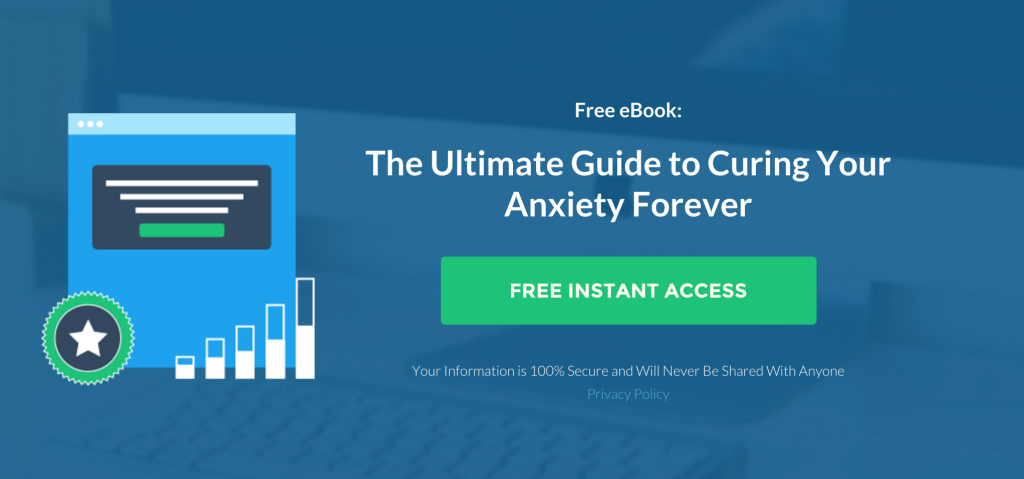
Ehhh…not so sure I buy that.
You may believe your free five-page ebook has the power to make all of a prospect’s hopes and dreams come true, but you’re setting yourself up for a tough sell if you go all-in on promising that with the headline.
The good news is that, in most cases, your lead magnet doesn’t need to help your prospects fulfill all their hopes and dreams. It just needs to get them a quick win.
Solving someone’s emotional pain can never be accomplished with a quick win, which is why your lead magnet and headline don’t need to be selling that. Instead, focus on helping them take a baby step toward solving that emotional pain.
For example, if you help people overcome anxiety, a good lead magnet might be something like a guide to the five best meditation apps, rather than something like “The Ultimate Guide to Curing Your Anxiety Forever.”
A good opt-in page offer is simultaneously clear and concrete, while also inciting curiosity.
When I worked at LeadPages, we always used the example of a simple opt-in page that featured a headline reading, “Free Report Reveals: The 5 (Dirt Cheap) Tools I Use to Create All My Videos (Including My $80 HD Video Camera).”
If you’ve ever used their product, you’ve seen that headline. But there’s a reason they continue to use it as an example over and over again—that style of headline works really well on opt-in pages.
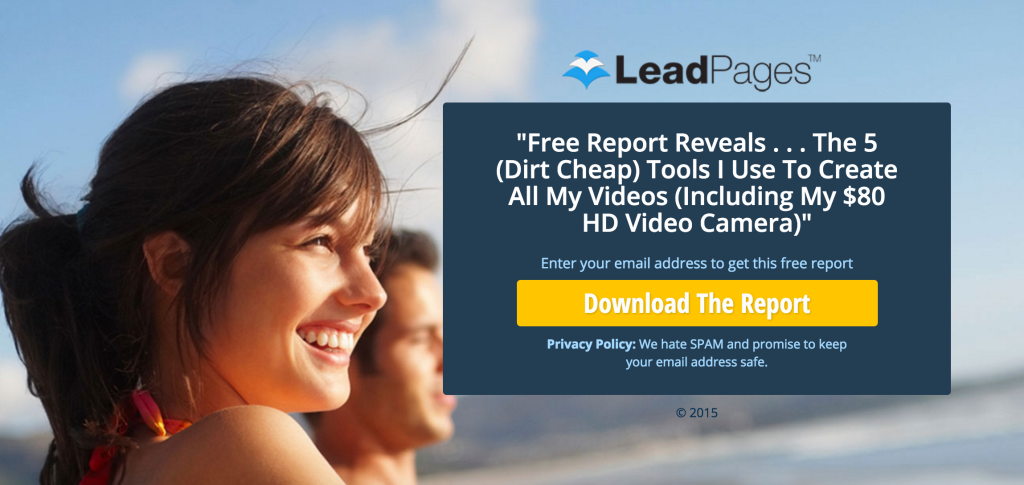
(Side note: It’s so sad this woman is doomed to continue smiling when people replace that headline with terrible ones.)
Here’s why that type of headline works well on opt-in pages: It incites curiosity (“The camera’s only $80? I wonder how cheap the other stuff is…”) while also implying value (“If I have the same tools as the pros, I can make videos like the pros”).
That combination is all you need to convince a large percentage of visitors to part with their email address.
Make a surprising but realistic promise with your opt-in page headlines, and follow it up with a lead magnet that delivers.
Remember—the real challenge starts after you have the email address.
How to Write Headlines for Facebook Ads
Facebook ad copy is my favorite copywriting topic to nerd out on right now.
Why? Because, for the majority of businesses, Facebook is the most exciting advertising platform out there right now.
The sheer volume of users and depth of targeting they offer marketers is amazing, and I don’t think there’s anything else in online advertising that comes close to the ROI potential it currently offers businesses.
Writing successful headlines and ads on Facebook, however, demands a different thought process than anything else we’ve discussed so far in this post.
Specifically, I want to focus on writing ads for the news feed, which are the kind that have brought my clients and me the best results. News feed ads appear as posts within the news feed where you view posts/updates from all of your friends. They look like this:
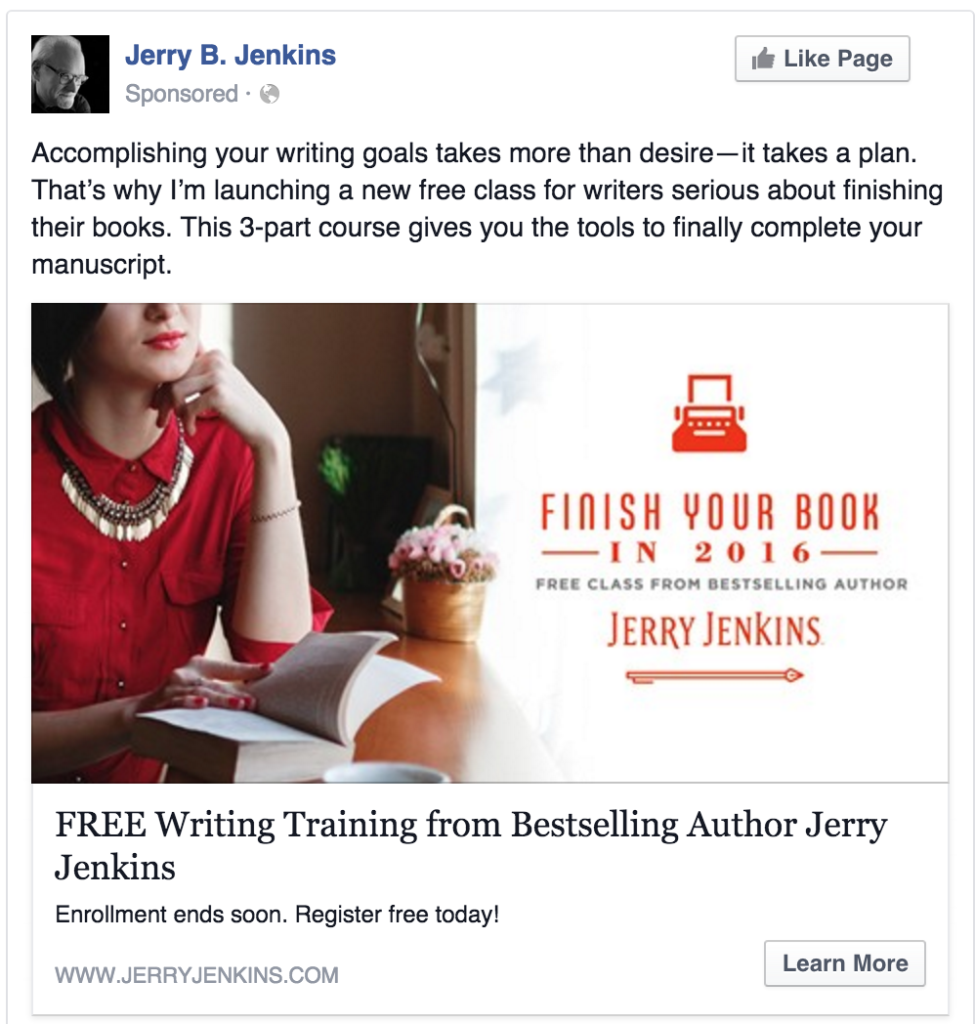
There are five main components that make up a Facebook ad:
- Text
- Image
- Headline
- Link description
- Call to action
Check them out:
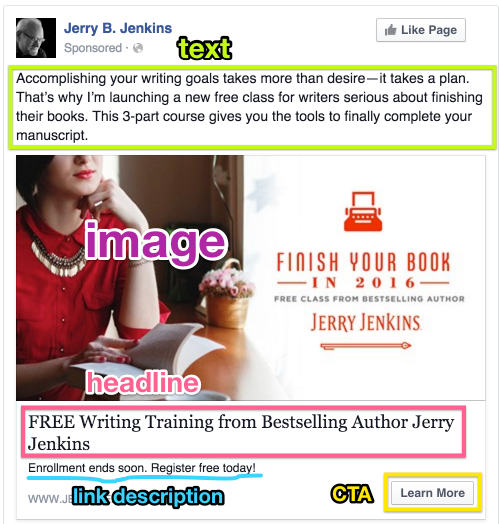
Notice what makes Facebook news feed ads different from everything else we’ve talked about?
That’s right—the headline is 3/4 of the way down the entire ad. It’s one of the last things you see!
Which means, when we talk about how to write headlines that will convert well on Facebook ads, we do ourselves a disservice by only focusing on the part that’s actually called the headline.
Facebook ad headlines are usually of secondary importance to the ad as a whole. The two most important parts of the news feed ad are the opening sentence of the area Facebook refers to simply as “text,” and the image/image text.
To understand why those are more important than the headline, consider the context in which the ad appears:
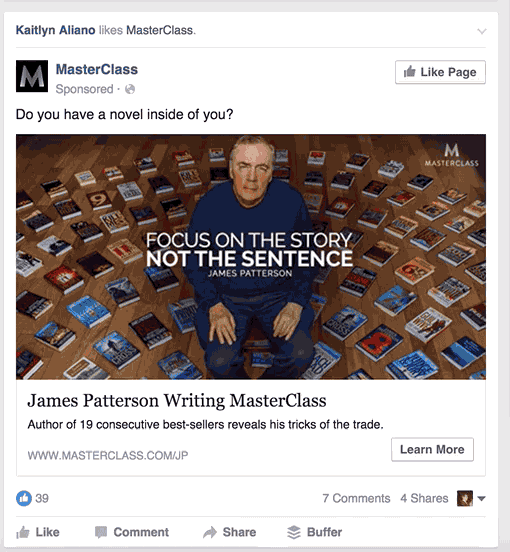
It’s possible the headline would be the first thing to have a chance at snagging a prospect’s eyes while they’re scrolling rapidly through their news feed. So I’m not saying it’s meaningless.
But consider the way you read most posts in your news feed. You start with the text at the beginning.
At best, the headline is still in fierce competition with the other elements of the ad (mostly the text and image) to capture your attention first. So it shouldn’t be treated with the same reverence as an opt-in or sales page headline.
That’s why you should do the following to optimize the headline for eyeball snagging:
- Giving something away for free? Make sure the word free is in there.
- Clearly state what’s being offered. If you’ve targeted audiences you know have interest in the type of offer you’re promoting, make sure they can recognize it.
- Avoid simply restating the headline written on your image (if your image contains a headline, which it almost always should).
Check out the headline on one of Derek Halpern’s ads for his free webinar on creating online courses for a good example of the above guidelines (remember…the headline is at the bottom):
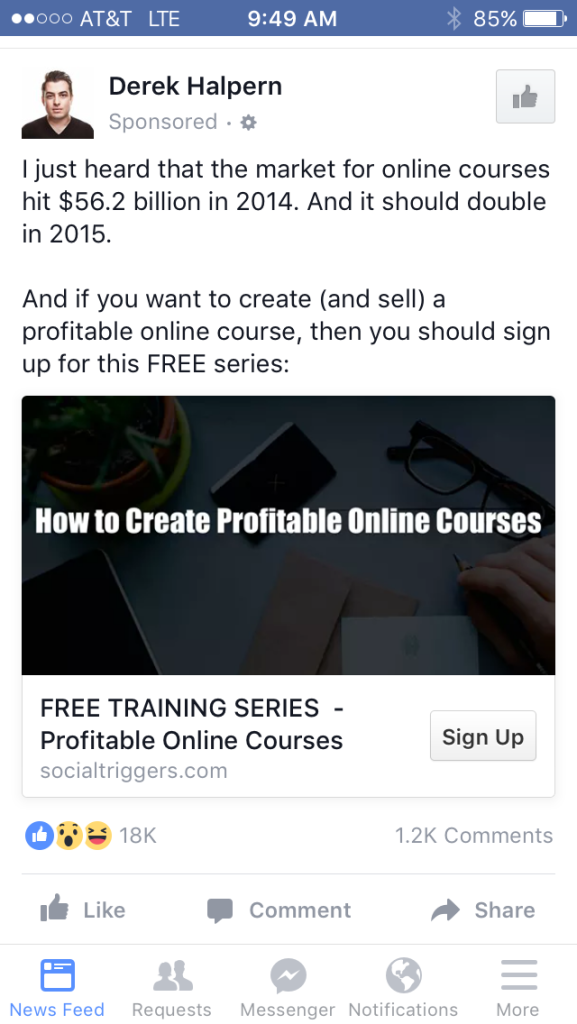
Now that I’m done putting the importance of Facebook ad headlines on blast, let me point you toward the part of the ad that should be treated with the reverence normally reserved for headlines…
The part Facebook refers to simply as “text.”
AKA the very first part of your ad people have the opportunity to see.
This:
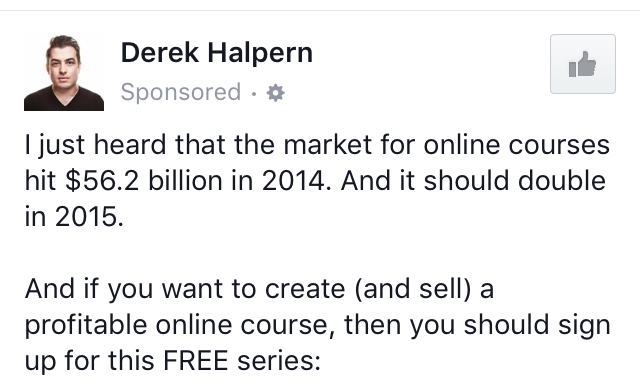
Although Derek should probably update this to reflect the current year, there’s still a lot of good things about this ad’s text. Specifically:
- It’s conversational. Remember the context in which a Facebook ad is consumed—it’s surrounded by personal updates from a prospect’s friends and family. The more your ad text feels like the rest of the updates they’re seeing, the better. “I just heard…” is a very natural way a friend would start a conversation with you, so it fits right in on Facebook.
- It clearly mentions the subject the audience is interested in right away. Clearly, Derek’s going after people interesting in online courses. He gets them reading right away with the conversational start and then ties their attention to something meaningful with the early mention of online courses.
- It ushers your attention to the action you’re supposed to take. Marketers often forget that the text portion of the ad doesn’t give prospects the opportunity to take action. That’s why it never hurts to remind them to check out or click on the rest of your ad like Derek does in his second paragraph. Just because other parts of your ad describe the offer doesn’t mean your text should ignore it!
The fact that the headline is usually the first thing people read is a big part of why they’re so important. In the case of Facebook ads, place that same level of importance on the beginning of the text.
How to Write Headlines for Blog Posts
The first place headlines were ever used was at the top of pieces of content.
The very first ones were likely written by a bunch of dudes in ancient Rome and China thousands of years ago, a few hundred years before Jesus hit the scene.
The rich, educated folks who ran their governments figured the common people might want to opt in for updates on how their societies were being ran. So they posted bulletins chiseled on things like wooden blocks, stone, and metal in public places so people would know what was up.
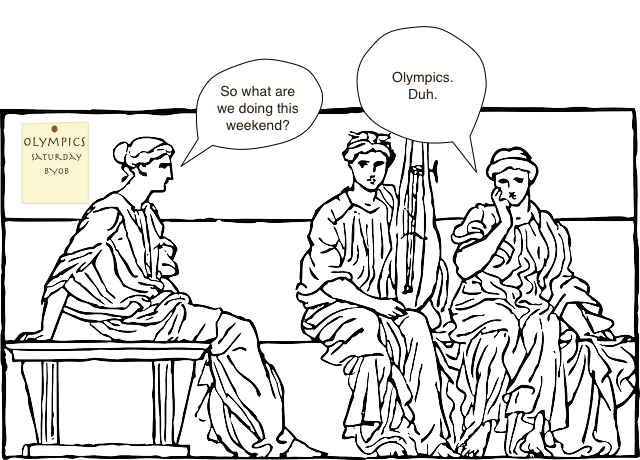
These headlines had pretty much the easiest job in the world. Since there weren’t a bunch of other articles competing for attention, the headline didn’t have to be all that exciting. Its mere existence was enough to draw interest.
By the time the printing press came around, however, competition had naturally increased. Titles and headlines became more important. Competition’s ability to bring out not only the best but also the worst in people was evident with the rise of things like yellow journalism.
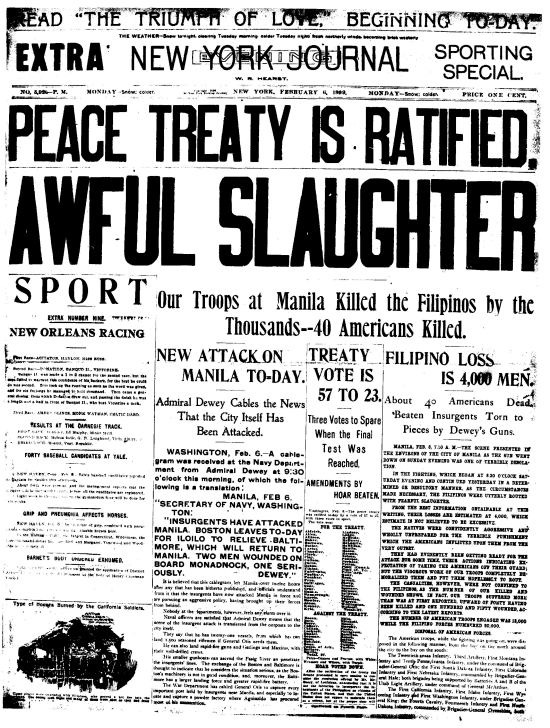
The market online publishers are facing now is more crowded than ever. Some three-year-old data I found says the following happens every 60 seconds:
- 347 new posts are published on WordPress blogs
- 41,000 posts are published to Facebook
- 278,000 tweets are sent out
- 204 million emails are sent
Like I said, that data is three years old. I wouldn’t be surprised if those numbers had doubled by now.
The point is this: a piece of content’s headline is probably a bigger factor in its success now than it has ever been at any other point in human history.
How to write an effective one could be its own 5,000-word blog post. Hell, it could probably be its own book.
So for the purpose of this section I want to stick to a few big picture guidelines for writing effective blog post / article headlines that get overlooked way too often:
1. Identify Your Goal
If you’re going to invest your time in developing content, every piece you create needs to have a goal. That might mean any of the following:
- Building your email list
- Ranking in search engines for a certain keyword
- Driving traffic to your website
- Delivering value to your audience
- Increasing demo requests
- Increasing sales
Obviously, you’d love for all of these things to happen. And sometimes a single piece of content accomplishes more than one. Many of these can be effects of one another (if you write a blog post that accomplishes the goal of ranking #1 for a popular keyword, that post will absolutely increase traffic to your website and will likely also build your email list).
The point is, you usually start with one goal. Which leads to the rule that should ultimately shape your headline…
2. Understand Your Channel
Remember all those articles and posts being published every 60 seconds? It’s time to make an important distinction about them.
While it’s true they’re all published in one giant place (the internet), they’re not all necessarily competing in the same space.
That’s because there are many different channels in which you can publish and promote content. Each of those channels offers a unique experience you can optimize your headline to best fit.
And within those channels, there are many different audiences you can optimize your headline toward.
Picking the channels where you want to publish and promote comes down to answering one question: What kind of traffic do you want?
(Note: I promise this is related to the headline. Hang tight. 🙂
Let’s say you have a website that teaches basketball players how to improve their shot. You want to write an article that ranks on page 1 of Google for the search “how to shoot a three pointer.”
There are instantly two things that should influence your headline more than any headline templates out there:
- The keyword you’re trying to rank for (you’ll most likely want it in the headline, preferably near the beginning)
- The headlines of all the articles currently ranking on page 1 for that term (you need to write one that’s going to instantly stand out from all the others)
Now, if you were publishing the same information as a post on Facebook, you would approach the headline differently. Rather than titling it in a way that will please Google, you’re looking to snag the eyes of people scanning their news feed.
Something conversational and curiosity-boosting might work infinitely better in this scenario. For example, “I Used to Be a 21% 3-Point Shooter, Until This One Drill Doubled My Accuracy.”
Let’s take it a step further. Maybe you not only want people on Facebook to read and share this article, you want fans of a specific team to read and share it. Now it becomes, “The Golden State Warriors’ Secret to a League-Leading 3-Point Percentage.”
3. Select the Proper Template
You never want to select a headline template before you think about numbers one and two. Just because a particular style of headline worked well for one blog post doesn’t mean it’s going to work well for yours.
Make sure whatever you’re using in aligned with your goals.
Anyone can use a headline template. The process that helps you pick the right template to use is what makes all the difference.
Where to Find Awesome Blog Post Headline Templates:
Rather than focusing on templates themselves, I wanted to focus this part of the post on giving you a process for selecting the right ones. Now that you have that, here are some of my favorite headline template sources:
- Joanna Wiebe of Copyhackers provided a great list of headline formulas here. Notice that she says these are for use on lead-gen pages, marketing ebooks, or blog posts. Some work better on certain ones of those than others, but they should all at the very least give you ideas for blog posts. NOTE: You should probably go ahead and bookmark that entire post. It’s insanely useful and you’d be crazy not to use it. Thanks, Joanna!
- Jon Morrow of Boost Blog Traffic’s Headline Hacks is a classic. And you’ll notice that it’s aimed at helping you “write blog posts that go viral.” These are headline templates specifically written for blog posts.
- Kevin Duncan of Be a Better Blogger offers a ton of helpful advice as well as dozens of templates in the “Choosing a Title” section of his epic guide to writing a blog post.
How to Write Email Subject Lines
The email subject line is where people most frequently apply the wrong type of headline templates.
It’s easy to think that what makes a good blog post title will also make a good subject line, but—with a few exceptions, which I’ll discuss—that’s often not the case.
Instead, everything I’m seeing in my clients’ (and my own) open rates tends to back up the idea that subject lines should be conversational. I think Samuel Hulick from UserOnboard.com said it best in this article he wrote for Help Scout:
“Writing compelling subject lines is an art unto itself, but the best cheat code I’ve found for ones that lead to high open rates is to keep things as close as possible to the kind of subject line you’d send a friend.”
A quick review of my recent subject lines and open rates confirmed this to be true for my email list. The top four are clearly the most casual and conversational:
sucky home page copy: 36.6%
This checklist = better copy ????: 36.6%
annoying question: 36.3%
Question for you: 34%
Here’s how MailChimp writes copy that delights: 33.6%
Is your copy just “meh”? ???? Here’s how to find out…: 31.5%
’tis the season for bad copy ????????: 31.2%
How to sell like Elon Musk (plus another giveaway): 30.7%
I’ve seen the same style of subject line work really well for other lists lately too.
For example, “Just checking in on you” got a 22.4% open rate for a client (above average for their list), while the less conversational “You Need a Mission Statement (Here’s How to Write It)” only got an even 18%.
And I’m not the only one on the conversational subject line train. Check out these from Joanna Weibe at Copyhackers:
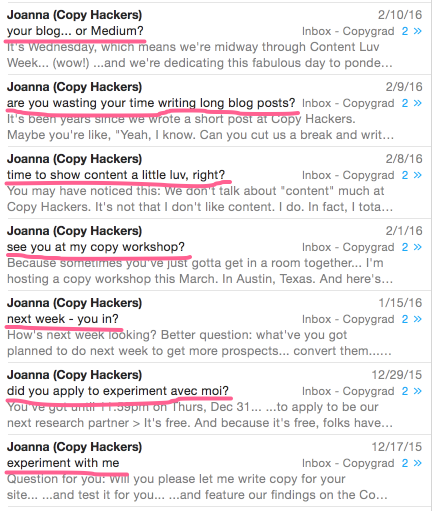
And these from Kevin Rogers at Copy Chief:
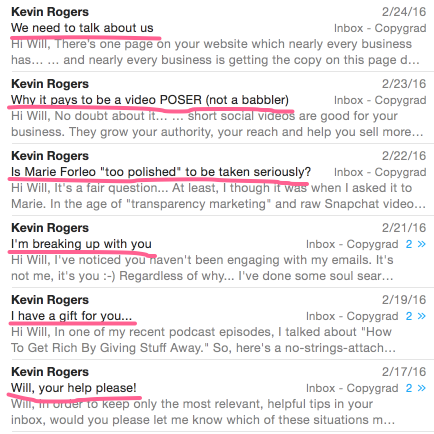
And these from Bryan Harris at Videofruit.com:
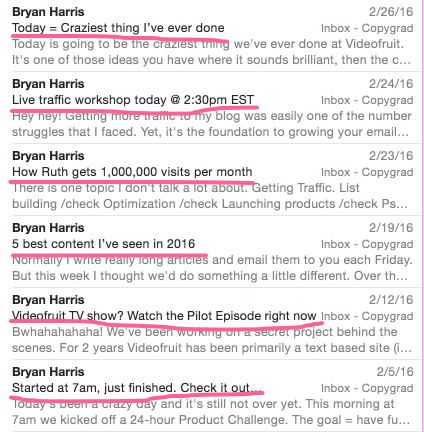
Joanna and Kevin are both phenomenal copywriters who test and optimize the crap outta their copy. Bryan knows more about building and maintaining an email list than 99.9% of people out there.
If they’re doing something, you can trust there’s a compelling reason why.
This all comes with a major caveat though:
Open rate is not the only metric that defines a subject line’s success or failure.
Remember those two client subject lines I compared? Here are the complete metrics for them:
Subject 1: Just checking in on you (22.4% open rate)
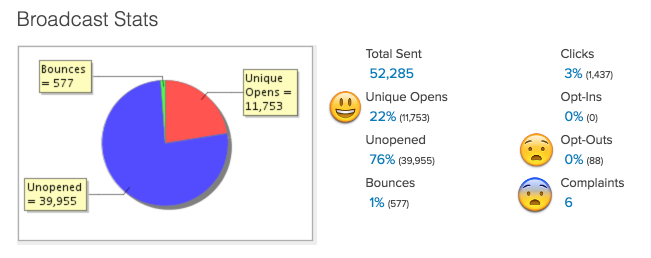
Subject 2: You Need a Mission Statement (Here’s How to Write It) (18.0% open rate)
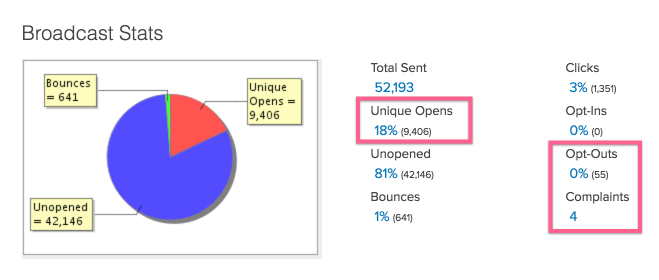
The conversational Subject 1 had significantly higher opt-outs and complaints. And despite having 2,347 fewer opens (and being sent to 92 fewer people), Subject 2 only had 86 fewer clicks!
What’s the deal?
While Subject 2 had a significantly lower open rate thanks to its less-than-conversational subject line, the people who opened it knew exactly what the content of the email was about—a personal mission statement. Since they knew that going in, a higher percentage of openers became clickers.
And there’s the challenge: While conversational subject lines can achieve great open rates, the best ones also tie into the email’s content, which can improve click rates.
Let’s take a look back at two of my top three recent subject lines based on open rate and see what their click rates were:
Email 1: annoying question
- Open rate: 36.3%
- Click rate: 9.2%
Email 2: This checklist = better copy ????
- Open rate: 36.6%
- Click rate: 16.0%
When you evaluate the content of each email, it’s easy to see why Email #2’s click rate dramatically outperformed Email #1’s.
“annoying question” is certainly a subject line that would stand out in your inbox. But the email doesn’t actually contain an annoying question for you. Instead, it brings up an annoying marketing question people often ask and then links to a blog post that teaches you how to write headlines.
Rather than asking you an annoying question—which is what the headline implies—it’s just identifying one in order to set up the premise of a blog post.
“This checklist = better copy ” keeps things conversational, but also gives you an idea of what the email contains—a checklist that will help you next time you’re writing copy. Since you were already interested in the idea when you opened the email, the likelihood of a click increases.
While I believe the subject lines had the biggest effect on the click rates, it’s worth noting that the content of the emails also had some level of influence on them too.
“Cool, so how do I actually write good subject lines, though?”
Oh yeah, I knew there was a reason we just went through all that!
My best advice hearkens back to the earlier quote from Sam—writing good subject lines is less science than it is knowing your audience and understanding how to talk to them.
Stray from the typical headline formulas most marketers mistakenly plug into subject lines and do this quick mental exercise instead:
Imagine the person you talk to most about whatever topic your email is about. That might be a:
- Friend
- Client
- Customer
- Blog commenter
- Spouse
- Colleague
- Etc.
Whoever it is, it’s someone who would be excited about the information you’re about to send. Now, write the subject line as if you’re sending it to only that single person.
Visualizing that person will help you keep the subject line conversational. If you want to make sure it’s relevant to the content of the email, simply ask yourself this: What will the reader be able to do after they read this? Work that result into your conversational subject line.
The important thing to remember is that the subject line is one of the best (and easiest) places to experiment in your marketing. One email is likely not going to make or break your business.
So get creative.
Borrow unique things you see others doing and figure out ways to make them your own.
Break away from the typical templates and use this as your opportunity to stand out in your subscribers’ inbox.
How to Write Headlines for Home Pages
Home page headlines are among the most difficult to write for one simple reason:
Out of all the types of pages for which you write headlines, your home page most likely receives the most diverse traffic—different types of people are coming for different reasons!
It’s much different from creating a landing page, which is ideally written to get a specific audience (sometimes coming from a single traffic source) to take one action.
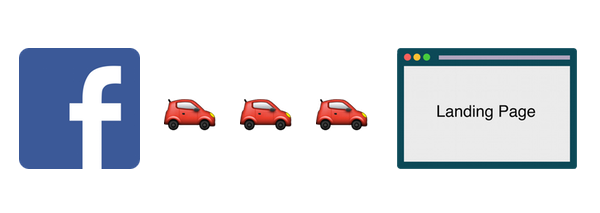
Your home page, on the other hand, is visited more frequently than any other page on your website (in most cases).
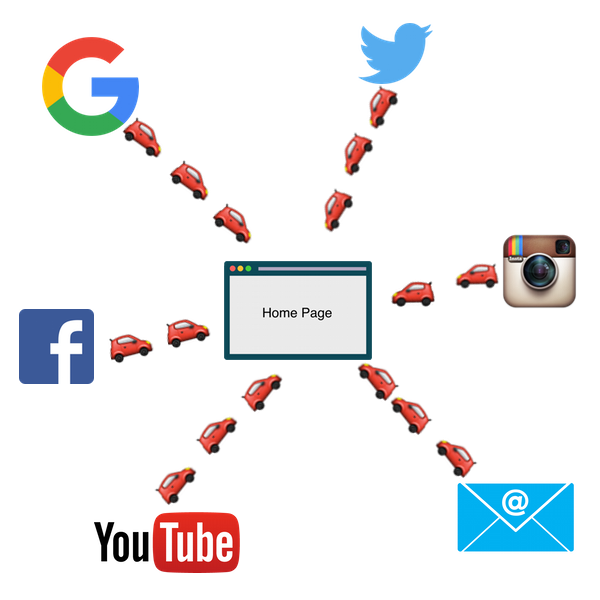
Everyone from super-engaged prospects to people who are discovering you for the first time are arriving on your home page every day. So how do you write a headline versatile enough to speak to so many different types of people?
The answer is you can’t. So don’t try.
No headline you create is going to be the perfect headline for every type of visitor who lands on your home page.
What you can do is cater to the type of person most likely to visit your page. How? By figuring out which stage of home page growth your business is in right now:
1. Validation (What you think customers want)
This is where every business starts. If you’re writing a home page for something that’s launching, you’re really just testing a hypothesis: that you’ve created a product the market wants, and you’ve presented it in a manner compelling enough to convince visitors to try or purchase it. At this stage, the people coming to your home page have little to no experience with your brand or product (after all, it just launched).
2. Co-Creation (What customers say they want)
Once you have customers, you can start talking to them to figure out why they bought your product or service. Depending on the product(s) you offer, those reasons may be extremely diverse. But most businesses will find at least one outlier—some reason or motivation a large percentage of customers have in common, or specific words they use to describe the product or their experience with it.
3. Authority (What you know customers want)
Stage 3 is rare air. Most businesses fail before they make it this far. At this point, you have a deeper understanding of who your customers are, what types of customers you want to attract, and where you want to go as a brand. You’re not only listening to your customers, you’re also showing them things they might not be able to articulate a need for. You’re not just a player in your space—you’re an authority that’s leading your industry forward.
I wrote about these three stages extensively for Help Scout (so you can learn more about them there), but for the purpose of this post you need to understand that the way you write your headline depends greatly on which of these stages you’re in right now.
The most likely scenario is that you’re not in Stage 3 yet.

Hey, it’s not so bad! Don’t worry. As I said, it’s rare air. But there’s a reason why I bring it up.
When people sit down to dream up their home page, they often start looking at those of companies/products they love.
Apple:
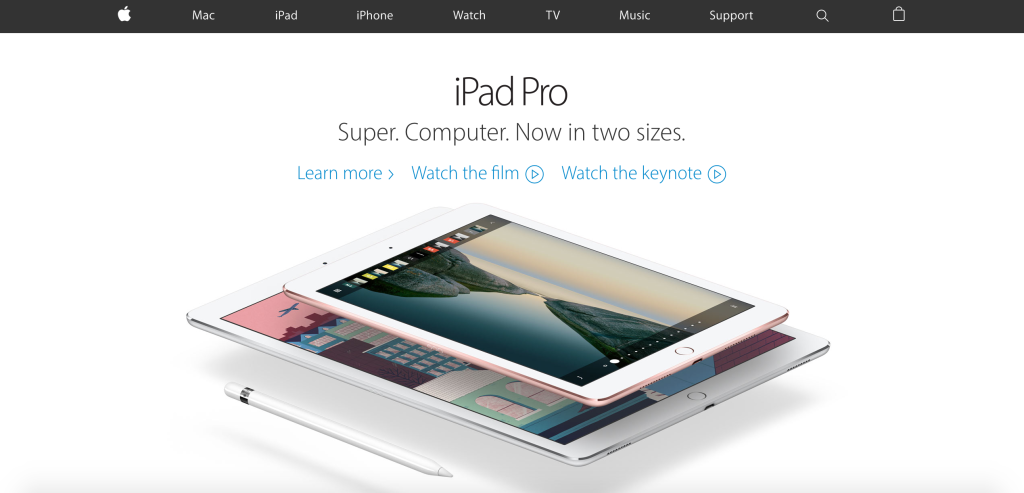
Slack:
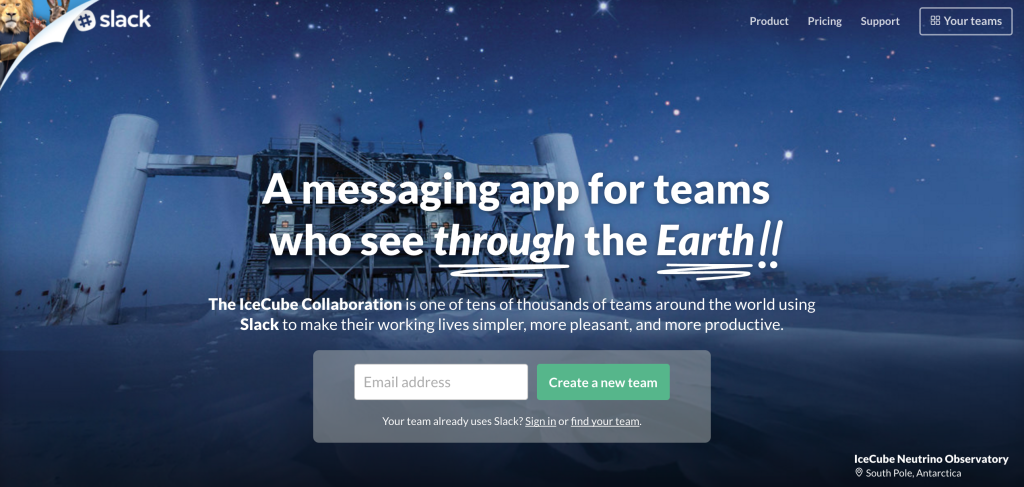
See the problem? Even though most businesses aren’t in Stage 3…they look to Stage 3 home pages for inspiration!
Since almost everyone visiting Apple or Slack’s home page has heard of the company before, the copy is very product-focused.
Yet if you’re a Stage 1 brand, you’ll probably do better writing a headline that focuses on the problem or pain your product solves. Like the home page for Smart Bribe, a new product Bryan Harris just launched:
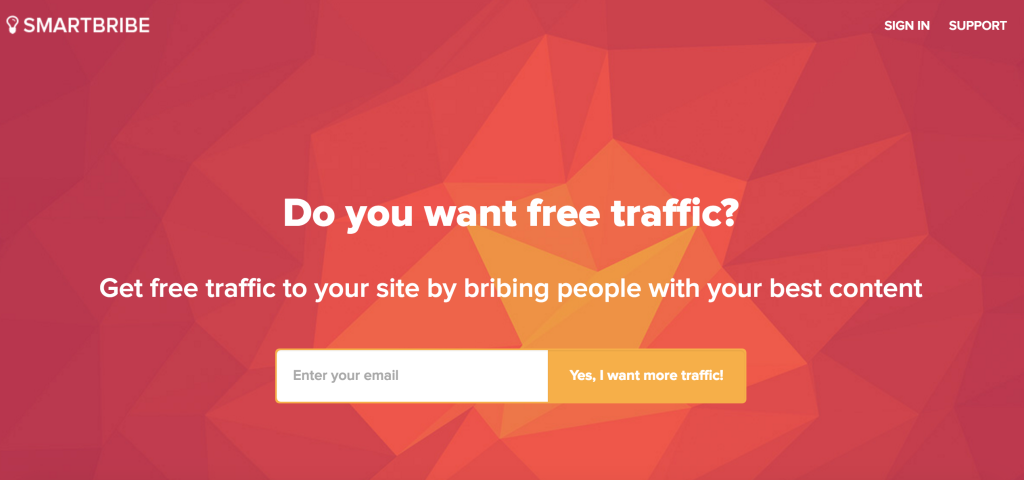
Rather than making a statement about the brand, the headline is focused solely on the want/need the product fulfills. Visitors will be much more familiar with that want/need than they will be with a brand new product they haven’t had that many opportunities to hear about.
If you’ve made it to Stage 2 and have feedback from customers about their problems or how your product solves them, all the better. You can incorporate those exact words and phrases into the headline to make it even more effective.
What the Home Page Headline Actually Does
Your home page headline is not going to solve all of your problems.
It’s not going to be the thing that closes every sale or converts every opt-in for you.
For some visitors, it’s simply going to be an introduction to your brand. It may be what helps them read to the parts of the page that talk through the many problems your business solves. That’s why almost all home pages don’t end after the first call to action.
Take the Crazy Egg home page, for example:
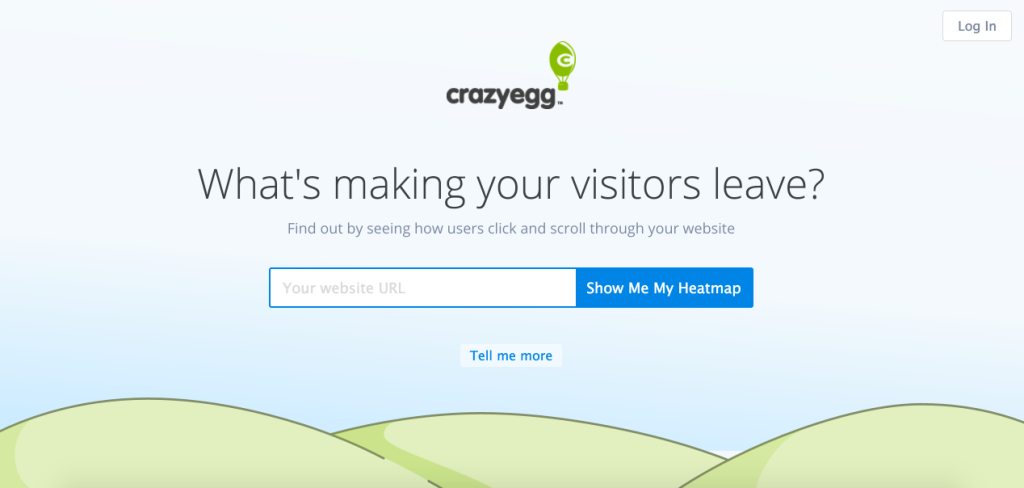
That’s the entire home page. If you’re a visitor who knows what Crazy Egg and heat mapping tools are, this is probably all you need to be sufficiently motivated to enter your website URL and generate a heatmap.
But what if you’ve never heard of Crazy Egg and don’t even know what a heatmap is? Then that little “Tell me more” button is there just for you:
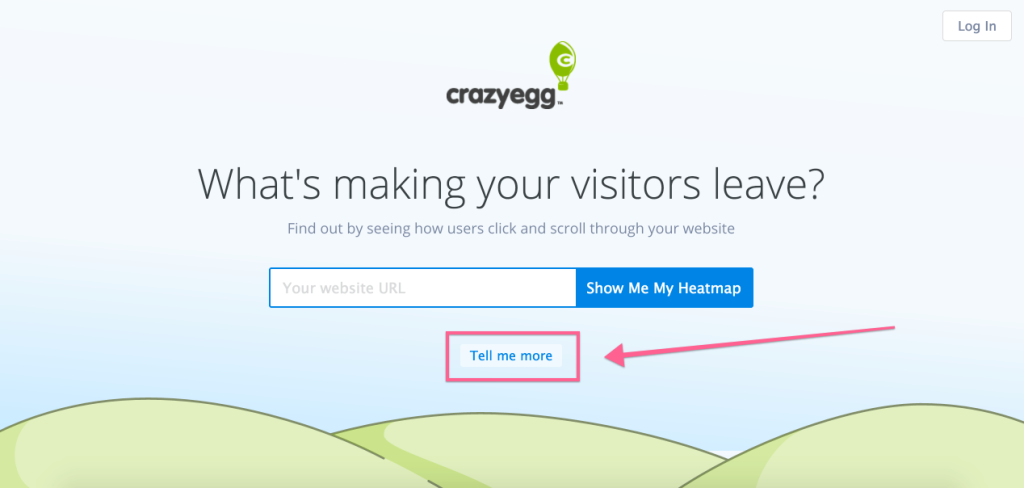
Once you click it, the home page expands and you can scroll to view more info:
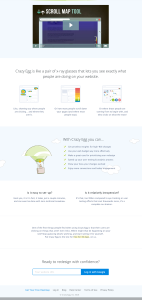
There’s a demo video, screenshots, bullet points highlighting benefits, and more. Basically, information for the less-qualified prospect.
But notice how the headline was still broad enough to generate interest from both types of visitors: “What’s making your visitors leave?”
This is a great example of a home page / headline that’s able to cater to multiple types of visitors without watering the message down to the point where it resonates with no one.
7 Questions to Ask When Writing Your Home Page Headline
When coming up with home page headline ideas, make sure to ask the following questions:
- Which stage of awareness is my brand in?
- How do existing customers talk about this brand?
- Does this help visitors quickly and easily understand what this page has to offer them?
- What’s the most common problem pushing people to come to this site?
- How are most people getting here? (If 70% of your traffic is coming from people searching “Atlanta web designer,” that should influence your headline.)
- What’s the most valuable action (within reason) someone could take after reading this headline? (This helps you determine what the earliest CTA should be, which will influence your headline.)
- What will readers want to know after reading this headline? (Knowing where you’re going can help you figure out if you’re starting the right way.)
For further reading on my process for writing home page headlines, check out this post: The 5-Question Formula for Writing Stand-Out Home Page Copy That Converts
How Do You Write Headlines?
These are my processes for writing different types of headlines, but they’re certainly not the only approaches out there.
I’m always looking for ways to improve them, so tell me—what’s your process for writing headlines? How do different types of headlines change it?
Leave a comment and let’s chat.
